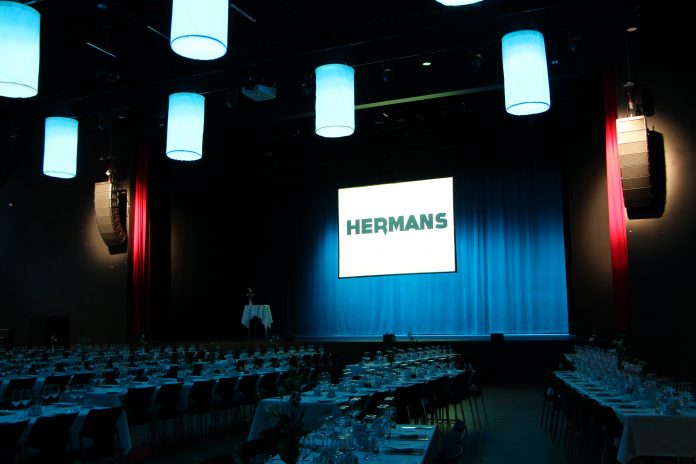Located in Aarhus – Denmark’s second largest city – Tivoli Friheden amusement park has long been one of the country’s most popular visitor attractions. Divided into multiple themed areas, the park features more than forty individual attractions to captivate children and adults.
Further enhancing its appeal, the park added a ‘new house of culture’ four years ago in the shape of Hermans. With room for 1,400 standing or 800 seated spectators, the venue has found favour for a wide variety of live music and theatre performances, as well as conferences and other meetings. Although an undoubted success, the venue has not been without its challenges.
Lars Baun Frederiksen from Alfa Audio – the Danish pro audio specialist that was ultimately engaged to work on a new audio system for the venue – remarks that there had been persistent complaints “about low frequency noise leaking out through the back of the building. Through individual investigations, and the involvement of a consultancy company, Delta Noise and Vibration, it became clear that more needed to be done to prevent sound from escaping at the back of the theatre and affecting residents closest to that location.”
One option that involved substantial building work was deemed to be undesirable on grounds of cost and impact on activities, so instead the focus turned to the possibility of installing a loudspeaker system that could deliver audio where required – and only where required.
“Our experience with d&b audiotechnik’s passive cardioid sub technology made us wonder if it would be possible to dramatically improve the situation at Hermans by installing such systems,” says Frederiksen. “So, in conjunction with sales partner Sound & Light we undertook a somewhat unscientific test of the noise levels behind the building using a d&b Y-Series speaker system with V-SUBs, and compared it to the performance of the existing house system. The improvement was substantial and immediate for all to hear.”
The results were further underlined by a more conventional assessment carried out by Delta Noise and Vibration, which revealed a reduction of 10-14 dB at the problem location when playing pink noise at 100 dB(A) at the FoH position. With this knowledge in hand, the venue decided to press ahead with a comprehensive overhaul based around d&b audiotechnik products.
At the core of the new system are two line arrays of four Y8 and four Y12 loudspeakers per side, augmented by a quartet of four V-GSUBs under each hang. The Y-Series arrays are optimised here via the use of ArrayProcessing. Increasingly in demand for concert hall and other demanding fixed installation applications, ArrayProcessing incorporates powerful filter algorithms that calculate and optimise the sonic performance of a d&b line array over an entire listening area.
“ArrayProcessing makes it even easier to deliver sound precisely where it is required,” says Oran Burns from d&b’s Education and Application Support team. “Put simply, ArrayProcessing ensures that every member of the audience benefits from the same remarkable quality of sound by enhancing the spectral consistency, with a defined level distribution, to achieve a consistent tonal balance for each listener.”
In the case of Hermans, “ArrayProcessing has made it possible to achieve the same sound from the first row to the last row. The variety of settings that it makes available is also advantageous, so it’s been a huge benefit all-round for this project,” says Frederiksen.
The new system also includes a single Y7P point source loudspeaker and six E6 loudspeakers for centre and front, respectively. Performers are able to make use of eight MAX2 2-way full range monitors, while amplification comprises one D80 and seven D20 amplifiers.
“The combination of ArrayProcessing, Y-Series, and passive cardioid subs has allowed us to get the necessary coverage throughout the venue, and deliver a big improvement on the noise leakage front, so we are very happy with the results,” says Frederiksen.
Jok Østergaard, who handles technical production at Hermans, says that work to minimise the impact on residents is continuing, but that “the new system has made it easier to control and limit the sound that leaves the venue. So that is great news, and so is the very evident improvement to audio quality within the venue.”
https://www.dbaudio.com/





